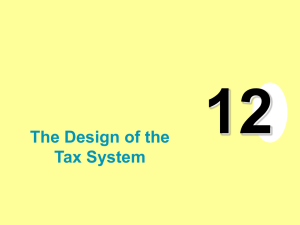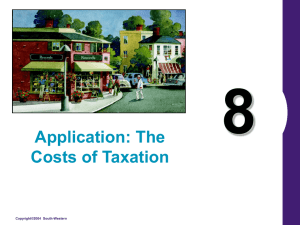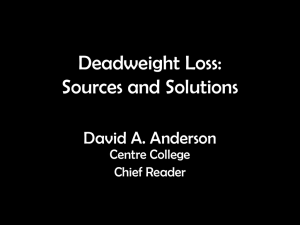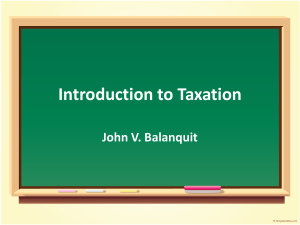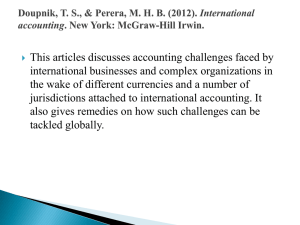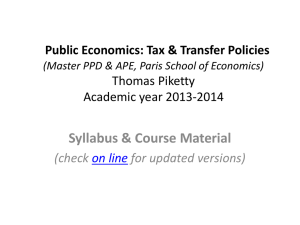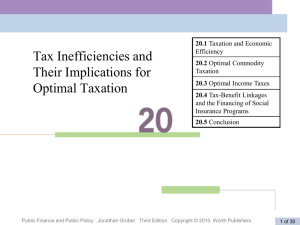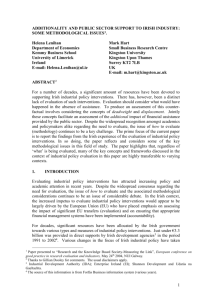Chapter 8
advertisement
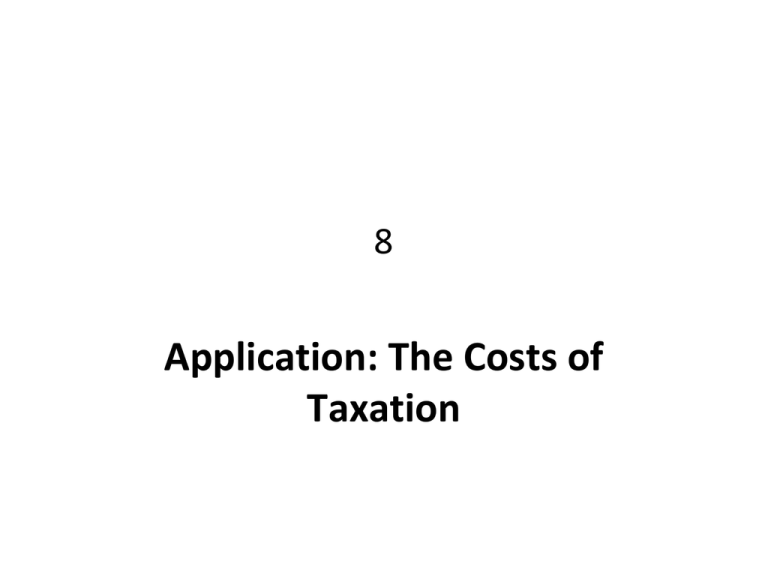
8 Application: The Costs of Taxation The Effects of Taxation • We saw in Chapter 6 how taxes – reduce the equilibrium quantity, – increase the price paid by buyers, and – decrease the price received by sellers. • We also saw that – It does not matter whether a tax is placed on the buyers or the sellers; • the outcome is the same in either case • But how do taxes affect the economic wellbeing of market participants? 2 CHAPTER 8 APPLICATION: THE COSTS OF TAXATION Welfare Economics • Welfare economics is the study of how the allocation of resources affects economic wellbeing. • We saw in Chapter 7 that – Buyers benefit from buying (consumer surplus), and – Sellers benefit from selling (producer surplus) – The equilibrium outcome in a perfectly competitive market maximizes the total surplus of society. 3 CHAPTER 8 APPLICATION: THE COSTS OF TAXATION Applying welfare economics to study the effects of taxation • In this chapter we will combine what we learned in Chapters 6 and 7 to compare the costs and the benefits of a tax 4 CHAPTER 8 APPLICATION: THE COSTS OF TAXATION Figure1 The Effects of a Tax Buyers’ Price Sellers’ price Supply Price buyers pay Size of tax Price without tax Price sellers receive Demand 0 Quantity with tax Quantity without tax Quantity How a Tax Affects Market Participants • A tax places a wedge between the price buyers pay and the price sellers receive. • Because of this tax wedge, the quantity sold falls below the level that would be sold without a tax. – See Chapter 6 for details • This fall in output is the cost of the tax 6 CHAPTER 8 APPLICATION: THE COSTS OF TAXATION How a Tax Affects Market Participants • Governments earn revenue from taxes • This revenue is the benefit of the tax • Tax Revenue – T = the size of the tax – Q = the quantity of the good sold T Q = the government’s tax revenue 7 CHAPTER 8 APPLICATION: THE COSTS OF TAXATION Figure 2 Tax Revenue Price Supply Price buyers pay Size of tax (T) Tax revenue (T × Q) Price sellers receive Demand Quantity sold (Q) 0 Quantity with tax Quantity without tax Quantity Figure 3 How a Tax Affects Welfare Price Price buyers = PB pay Supply A B C Price without tax = P1 Price sellers = PS receive E D F Demand 0 Q2 Q1 Quantity Deadweight Losses and the Gains from Trade • The cost of a tax exceeds the benefit of a tax • The decrease in total surplus that is caused by a tax is the deadweight loss of the tax • Taxes cause deadweight losses because they prevent buyers and sellers from realizing some of the gains from trade. 13 CHAPTER 8 APPLICATION: THE COSTS OF TAXATION Price Figure 4 The Deadweight Loss Lost gains from trade PB Supply Size of tax Price without tax PS Cost to sellers Value to buyers 0 Q2 Demand Q1 Reduction in quantity due to the tax Quantity DETERMINANTS OF THE DEADWEIGHT LOSS • What determines whether the deadweight loss from a tax is large or small? – The size of the deadweight loss depends on how much the quantity supplied and quantity demanded respond to changes in the price. – In other words, the size of a tax’s deadweight loss depends on the price elasticities of supply and demand. 15 CHAPTER 8 APPLICATION: THE COSTS OF TAXATION Figure 5 Tax Distortions and Elasticities (a) Inelastic Supply Price Supply When supply is relatively inelastic, the deadweight loss of a tax is small. Size of tax Demand 0 Quantity Figure 5 Tax Distortions and Elasticities (b) Elastic Supply Price When supply is relatively elastic, the deadweight loss of a tax is large. Size of tax Supply Demand 0 Quantity Figure 5 Tax Distortions and Elasticities (c) Inelastic Demand Price Supply Size of tax When demand is relatively inelastic, the deadweight loss of a tax is small. Demand 0 Quantity Figure 5 Tax Distortions and Elasticities (d) Elastic Demand Price Supply Size of tax Demand When demand is relatively elastic, the deadweight loss of a tax is large. 0 Quantity DETERMINANTS OF THE DEADWEIGHT LOSS • The greater the elasticities of demand and supply: – the larger the decline in equilibrium quantity and, – the greater the deadweight loss of a tax. 20 CHAPTER 8 APPLICATION: THE COSTS OF TAXATION The Deadweight Loss Debate • Some economists argue that taxes on labor income are highly distorting—that is, taxes on labor income have high deadweight losses—because they believe that labor supply is elastic. – Here are some examples of workers who may respond more to incentives: • • • • Workers who can adjust the number of hours they work Families with second earners Elderly who can choose when to retire Workers in the underground economy (i.e., those engaging in illegal activity) 21 CHAPTER 8 APPLICATION: THE COSTS OF TAXATION DEADWEIGHT LOSS AND TAX REVENUE AS TAXES VARY • With each increase in the tax rate, the deadweight loss of the tax rises even more rapidly than the size of the tax. 22 CHAPTER 8 APPLICATION: THE COSTS OF TAXATION Figure 6 Deadweight Loss and Tax Revenue from Three Taxes of Different Sizes (a) Small Tax Price Deadweight loss Supply PB Tax revenue PS Demand 0 Q2 Q1 Quantity Copyright © 2004 South-Western Figure 6 Deadweight Loss and Tax Revenue from Three Taxes of Different Sizes (b) Medium Tax Price Deadweight loss PB Supply Tax revenue PS 0 Demand Q2 Q1 Quantity When the tax rate doubles, the deadweight loss quadruples Figure 6 Deadweight Loss and Tax Revenue from Three Taxes of Different Sizes (c) Large Tax Price PB Tax revenue Deadweight loss Supply Demand PS 0 Q2 Q1 Quantity Figure 6 How Deadweight Loss and Tax Revenue Vary with the Size of a Tax (d) deadweight loss continually increases Deadweight Loss 0 Tax Size DEADWEIGHT LOSS AND TAX REVENUE AS TAXES VARY • As the size of a tax increases, its deadweight loss quickly gets larger. • By contrast, tax revenue first rises with the size of a tax, but then, as the tax gets larger, the quantity bought and sold shrinks so much that tax revenues start to fall. 27 CHAPTER 8 APPLICATION: THE COSTS OF TAXATION DEADWEIGHT LOSS AND TAX REVENUE AS TAXES VARY • Tax revenue = tax rate × quantity bought and sold – TR = T × Q • • • • • T↑ causes Q↓ Therefore, the effect of T↑ on TR is ambiguous T↑ causes TR↑ when the tax rate (T) is low T↑ causes TR↓ when the tax rate (T) is high This gives us the Laffer Curve 28 Figure 6 How Deadweight Loss and Tax Revenue Vary with the Size of a Tax (e) Tax revenue first increases, then decreases (the Laffer curve) Tax Revenue Note that it makes no sense at all to make the tax size bigger than T1. 0 T1 Tax Size CASE STUDY: The Laffer Curve and SupplySide Economics • The Laffer curve depicts the relationship between tax rates and tax revenue. • Supply-side economics refers to the view that a tax cut – would induce more people to work, and thereby – have the potential to increase tax revenues. • Large tax cuts were adopted during the Reagan administration • The results do not settle the debate on the validity of supply-side economics 30 CHAPTER 8 APPLICATION: THE COSTS OF TAXATION CASE STUDY: The Laffer Curve and Supply-Side Economics • Between the early 1970s and mid 1990s, the French tax rate rose to 59 percent from 49 percent, while the U.S. tax rate held at 40 percent • The average French person of working age logged 24.4 hours a week in the early 1970s, one hour more than an American. By the mid 1990s, the French workweek had shrunk to 17.5 hours, while the U.S. workweek had grown to 25.9 hours – Data from research by Edward Prescott 31 CHAPTER 8 APPLICATION: THE COSTS OF TAXATION CASE STUDY: The Laffer Curve and Supply-side Economics Country Tax Rate Workweek Italy 64% 16.5 hours France 59 17.5 Germany 59 19.3 Canada 52 22.8 UK 44 22.9 USA 40 25.9 Japan 37 27.0 Data from research by Edward Prescott 32 CHAPTER 8 APPLICATION: THE COSTS OF TAXATION The Price of a Civilized Society • This chapter has focused on the negative effects of taxes on buyers and sellers in a market • However, without taxes we would not have a functioning government • As Oliver Wendell Holmes, Jr., Supreme Court Justice, once said, “Taxes are the price we pay for a civilized society." 33 CHAPTER 8 APPLICATION: THE COSTS OF TAXATION Summary • A tax on a good reduces the welfare of buyers and sellers of the good, and the reduction in consumer and producer surplus usually exceeds the revenues raised by the government. • The fall in total surplus—the sum of consumer surplus, producer surplus, and tax revenue — is called the deadweight loss of the tax. 34 CHAPTER 8 APPLICATION: THE COSTS OF TAXATION Summary • Taxes have a deadweight loss because they cause buyers to consume less and sellers to produce less. • This change in behavior shrinks the size of the market below the level that maximizes total surplus. 35 CHAPTER 8 APPLICATION: THE COSTS OF TAXATION Summary • As a tax grows larger, it distorts incentives more, and its deadweight loss grows larger. • Tax revenue first rises with the size of a tax. • Eventually, however, a larger tax reduces tax revenue because it reduces the size of the market. 36 CHAPTER 8 APPLICATION: THE COSTS OF TAXATION
